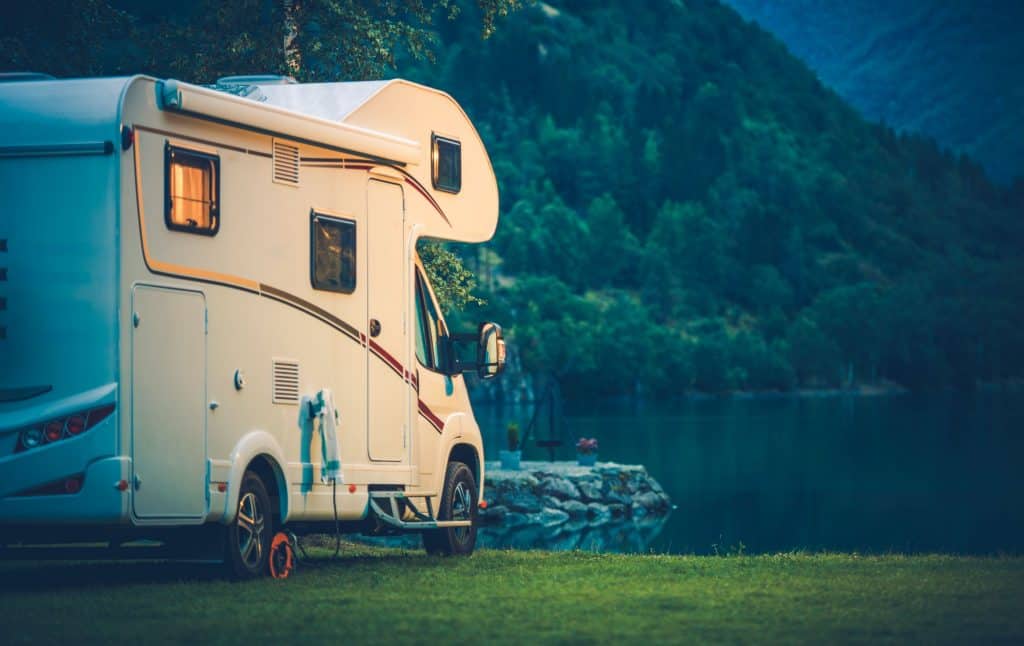Is A Full-Time RV Lifestyle Right For You?

By The Sharp Edge
Since the onset of Covid-19, many Americans are re-evaluating their lifestyles in search for ways to live freely from debt and government overreach. The influx of lockdowns, mandates, inflation, and ‘woke’ agendas since the plandemic have caused many to crave a simpler way of life in which they can focus on the things that truly matter. The rising costs of food, gas and housing have prompted buyers to contemplate a shift in their lifestyles that they may have never previously considered. Following the emergence of Covid-19, the employment landscape has changed as well. Many Americans have found ways to work from home, untethered from the restraints of job sites and offices. With all things considered, naturally more Americans have chosen the daily life of full-time RVing. What are some of the challenges these full-time RVers face and how do they overcome them? More importantly, is the full-time RV lifestyle right for you?
RV & Remote Working Statistics
- 2021 was a record-breaking year for new RV shipments, reaching a total of 600,240 (nearly 170,000 more than 2020).
- Shipments of new RVs for 2022 are on track to be the second best year on record, down 8.4% from 2021, with projections reaching a total of 549,900 by the end of 2022.
- About 11.2 million households own an RV, split nearly evenly between groups over 55 and under 55.
- There is a notable growth in RV ownership for 18- to 34-year-olds, representing 22% of the total market now.
- Approximately one third of RV owners surveyed are first-time buyers.
- Full-time RVers make up only 1.5% of the total RV owners. Only 35% of full-time RVers are over age 55, and less than half (43%) are retired.
- About 4 out of 10 workers are currently working from home part of the time or fully.
- Of those surveyed who have remote-capable jobs – 24% expect to work exclusively from home for 2022 and beyond.
Full-Time RV Living Challenges & Solutions
The thought of leaving your troubles behind and exploring the great outdoors might be tempting, but the reality of full-time RVing is much different. Making the move to radically change your standard of living, from a 3 bedroom home in the suburbs to a 2 bedroom travel trailer, should not be taken lightly. There are several challenges full-time RVers face, which should be considered, before making that big decision. Even considering the rising expenses, many full-timers will say they’re saving money, compared to the costs of living in a home. The difference in cost will vary for each household. The only way you will know if camping full-time is worthwhile for you will be to draw up a detailed cost comparison that is specific for your situation.
Cost of RVs
The cost of RVs, like most things, has skyrocketed since 2020, driven by booming demand and supply shortages. Like the housing market, RVs have reached peaks that we’ve never seen before. Since Covid arrived, some homeowners have chosen to sell their homes, pay off debts, and buy a camper to live in with their profits. However, the vast majority of RV buyers are not full-timers, and many people have opted to finance their rigs. The price of an RV can range widely, from the comparative costs of a car to the costs of a home. As the economy continues to make a drastic downturn, it is expected that many RV owners, who consider their rigs to be a luxury item, may sell their RVs to eliminate some debt. A surplus of used RVs may go up by the end of 2022 or into 2023, which could drive used RV prices down. New RV sales have been projected by the RV industry to slow down in the later part of 2022. In short, now may not be the best time for most people to accrue more debt or buy a new RV. Later in 2022, or perhaps 2023, may be more of a buyers’ market. For those who are considering buying an RV, now is a smart time to create a financial plan, eliminate other debts, and save up.
Cost & Availability of Trucks
Along with the cost of buying an RV, there are many other costs associated with the camper life. If you plan to pull a travel trailer, you will need to make sure that you have a truck with a towing capacity that can handle your trailer when it’s fully loaded. Like RVs, the cost of trucks has exploded, with new and used trucks breaking records for price increases over the past 2 years. Many have complained about the short supply of trucks on the market. It’s a little early to tell if rising gas prices will slow down the sales of trucks, which may drive the costs down. As with RVs, some truck owners may choose to sell their trucks to eliminate debt in this economic climate. This may, in time, add more supply of used trucks on the market.
Camping Fees & Availability
The surge in campers on the road over the past couple of years, has created a shortage of available RV campsites – especially on the weekends. Full-timers have noticed price increases for campsites, as well as the need to plan well in advance. To keep costs down, full-timers often choose to boondock or join memberships that provide RV sites without camping fees. Not all rigs are set up for boondocking; so, it’s important to consider the added cost of equipment necessary to camp without hook-ups.
Cost of Gas & Propane
Some full-time RVers stay in one place year-round, while others choose to roam. The cost of gas has also shot up, prompting nomadic campers to alter their travel plans. While on the road, there are some tips to use your fuel more efficiently, such as: keeping your tires inflated, keeping your vehicle maintained, going slow and easy, using cruise-control, and using the air-conditioner sparingly. Also, some of the bigger gas stations will allow you to use their dumping stations for free if you fill up with their gas. The cost of propane has increased 19% since the start of 2022, but fortunately, there are plenty of options for reducing propane usage by utilizing alternative ways of heating and cooking.
Budget for Maintenance, Insurance & Roadside Assistance
Another aspect of RV living that should be considered is the cost of maintenance. RVs are notorious for their upkeep and maintenance costs. Full-time RVers should set aside a budget for monthly maintenance expenses. Having spare parts, like hoses, on hand is also worthwhile in case of emergencies. It’s best to have some maintenance skills and tools in order to do most repairs yourself. Of course, insurance is another expense to consider. Insurance costs will range based on the type of rig and your state; so, it’s important to consider this expense before making an RV purchase. Roadside assistance is a great option to consider for peace-of-mind while on the open road. Your RV dealer or your RV insurance company may offer a roadside assistance package.
Internet Equipment & Reliability
For those who are considering working remotely from an RV, internet reliability is a must. Full-time campers who work from home often gripe about the troubles of spotty internet. Some campsites will have stronger internet than others, while some campsites may have no internet at all. If internet is essential for you, then planning your destinations ahead of time is highly recommended. There are numerous camping apps and websites to find a campsite that fits your internet needs. There are multiple devices to help improve internet availability and quality such as: WiFi boosters, Mifi devices, and cell phone boosters. Having all the equipment necessary to work online from your RV can get pricey. Some employers may offer Mifi devices to their employees who work remotely. Do your own research to find what works best for your situation.
Downsizing
The amount of downsizing required to move from a home to an RV may come as a bit of a shock to most. Though some RVs have more storage room than others, no matter which RV you choose, it will involve efficiency and minimalism. It is important to take an inventory of the things that are absolutely necessary to bring and ask yourself if you are willing to get rid of the rest or budget for additional self-storage. Some items may have sentimental value, but simply aren’t practical for RV living. While the indoor space may be limited, the outdoors are boundless. Part of the RV lifestyle is incorporating the outdoor space into your living area. Many RVers will say they spend the majority of their time during the day in the great outdoors.
Homeschooling Kids & Activities For Families
For RVers with families, there is also the need to plan for homeschooling and activities. Some full-time RVers have chosen the roadschooling or unit study approaches for their children. Networking with other families that homeschool their children on the road may give you more insight as to how it works. Finding activities for the kids can be expensive, but websites that provide campsite locations will often list nearby sightseeing and activities. State parks or museums tend to be the most affordable activities for limited budgets. Full-time families often find that involving their children in the daily routine of RV homelife can be rewarding. The kids enjoy being part of the team and learning about everything from RV maintenance to balancing a budget and planning the next destination.
The full-time RV lifestyle isn’t for everyone, but for some it’s a way to be free from debt, government overreach, and societal chaos. Moreover, many full-time RVers find the simple life, surrounded by nature and loved ones, to be deeply satisfying. If you are considering living in an RV, it is important to take your time and do your research, including a budget and itinerary. Consider doing a search of “Full Time RV Living” groups on Facebook (where most of them are located) or other social media sites, where you have a platform to ask people about their experiences – the good, the bad and the ugly. More importantly, talk with your loved ones who will be coming along for the ride and gauge their commitment to a radical transformation in their lifestyles. Stay grounded in the reality of what a full-time RV lifestyle really means, and if it’s right for you, then go chase your dream.











8 Comments
RJ
Edge,
Great article. Well written. Ham Radios, Black powder firearms, and peddle electric/gas powered bicycles are also very useful in all 50 states while RV’ing. I really enjoy you and Corey’s big beautiful brains, spirits, and souls all these years. The next time you see each other, give yourselves a Great Big Bear Hug from another Fellow Human Being!
Always watching the Battlefield from a mountain afar…R.J. 🙂
P.S. 2 Yeasu radios paired in parallel can communicate with the ISS (International Space Station). They don’t always pick up so be patient:):)
Teresa A Bacon
Its gas that will keep them in the lot now. We bought a repurposed beautifully done one, cant get 1/2 for it now, and we can’t afford the gas to go!
Lea Walters
In Jan 2020 my husband and I made the decision to downsize and live in our 31 foot Motorhome while looking for a property that spoke to us. The transition took several steps.
And of course the pamdemic hit, real estate was difficult to go look at but we finally found the right agent for us.
We found a great deal on a hardly used 2019 destination trailer on a lot that was free hold. We are next to amazing old growth forest right along a river, on a bird and salmon habitat reserve. It is a Holiday park so we can’t live here full time, but it is our primary residence.
This was not our first time living small, and we planned almost everything. Having done this before prices went crazy was a blessing. The only thing we struggle with is content insurance.
We are in the Fraser Valley area, BC, Canada.
Thank you for the great article.
Lea
dard
great post,thanks Corey. ..but then there’s the elephant in the room…RV_unCrashworthiness…yikes!
cdn.shopify.com/s/files/1/1400/3519/files/RV_Durability_and_Crashworthiness.pdf
5pgs pics!!!
‘This motor home flipped and the entire house structure that was supposed to protect its
occupants disintegrated because the RV manufacturer used composite board without
reinforcement.
This photo shows why the sides, front, and back walls left the floor and exposed
the man and woman in the vehicle to the natural forces created by speed and weight.
They did
not survive… Driver was killed by a detached
cabinet! …This ‘sheetmetal” [!!] rollbar
allowed
the driver to be crushed.
…Many are disintegrating in
collisions under the barrier test speed of 35 mph set by the
National Highway Traffic Safety Agency (NHTSA), and
many are coming apart in rollovers. ‘
Walter K
Considering the topics and awareness I see here on coreysdigs, I am surprised an article on living in RVs is posted without any mention of the well-known health risks RVs pose. This is not new information, for example
https://abcnews.go.com/US/Health/story?id=3240532
If you search the internet for “RV toxic” or other phrases, you can read about many other issues such as mold. Personally, I think chemical off-gassing, lead, petroleum-based foams, etc. are a key concern because even in the last decade, we’ve learned so much more about how prevalent and dangerous this toxicants are. There are no regulations nor testing for these chemicals in RVs as well as most other portable vehicles and buildings.
I think people should at least be made aware of the risks before diving into what I agree seems a very attractive living option.
Rocky ralky
I had a pop up trailer first of all.
It was cheap and fun to sleep in untill one day I noticed the black ceiling. Mold was growing everywhere.
Tore off the ceiling, it was a disaster. Basically I gutted the whole camper.
I could see how cheaply these things are built.
Fast forward and I bought a motorhome, they look good inside and out but there is no regulations on building them.
They are a rolling death trap
Got to sell it.
Spike Protein
So 20 years ago we lived in a 40′ bumper pull park model for two years while building a house.
Never planned to travel with it. The OSSF for the house was installed early on,
so dumping the shitter was solved. We built a deck in the front, and lived with
two large dogs. We managed pretty well, sold it once the house was done,
and we swore “never again”.
Two decades later we retire, sell the house, and start from scratch on 20 acres in the Piney Woods.
We bought a 36′ fifth-wheel and parked it in an RV resort just before Thanksgiving.
We were ready to bail before Christmas. Moved into a crappy little starter home in HOA Hell
on New Year’s Day. Lost about $20k when we sold The Big Old Rollin’ Turd.
Robin Williams “RV” if you haven’t.
I would not recommend a fifth-wheel. Those steps up to the bath and bedroom are steep and treacherous.
One or both of us were gonna get seriously injured or worse. And the RV resort doesn’t allow decks,
so the steps leading into the BORT were equally hazardous.
We did get to meet several very nice full-timers several years older than us.
Don’t know how they do it.
LargeMarge
2003, we converted a 1996 Ford CF8000 commercial truck to our concept of an ExpeditionVehicle.
Within a week — while selling everything — we completed our conversion and hit the road from Oregon with the vague goal of ‘south’.
.
Twenty-four months twenty-four thousand miles around South America.
Alaska, Panama, all over North and Central America.
Summers up rough logger tracks to remote mountain lakes.
Winters on isolated Baja beaches.
.
Along the way, we accumulated a flexible resilient group of experienced travelers in similar home-built rigs… our ‘caravan chums’.
Among our zany madcap misadventures, we have at least several centuries of aggregate knowledge and skills.
.
We boondock exclusively.
I have zero-zero-zero interest in a RecreateVehicle park/resort… aka ‘mental-ward’.
Accordingly, our rig is stocked with months of chow, and water, and spares.
.
Our interior is 7.5′ x 12.5′, or in international measures, three paces across by seven paces long.
“But but but how can you live in such a tiny space!”
We do not live in our ExpeditionVehicle.
We live out of it.
.
Inevitably, while loading groceries, some scold will chastise us for our extravagance and our dismal mpg.
Our response:
“How many mpg do you get in your apartment?”
.
One of our hobbies is walking wrecking-yards aka ‘dismantlers’ and insurance auctions.
As the pretty decals are stripped, we get to examine the innerds of factory RecreateVehicles.
As one — astute and above-average — commenter notes, a factory RecreateVehicle is cobbled together with bailing-wire and chewing-gum.
.
We decided to build instead of buy after a year and a hundred thousand miles delivering RecreateVehicles manufacturer-to-dealer and dealer-to-shows.
While waiting for paperwork, we often walked the building floor.
As one example of the components, we watched a forklift raise a ‘frame’ to move it to the line.
The center of the frame was above our heads before the ends cleared the floor.
.
A factory RecreateVehicle is engineered for all the structure to work together — as a unit — for structural integrity.
A popular RV pastime is the fridge exploding in flames.
The galley is usually mid-ship, so a fire destroys a section of the wall and ceiling.
At the insurance auction, enter the standard door, and you are standing on a trampoline… the entire rig is ready — enthusiastically eager — to crumble to dust.
.
With our commitment to rural two-lanes and traipsing through rivers and trundling across deserts, we require a rig with substantially more resilience than a factory RecreateVehicle.
Any ‘industry-standard’ RecreateVehicle would (that phrase again…) crumble to dust the first mile.
.
A factory RecreateVehicle is designed to be used a few weekends annually, they were never engineered for full-time live-aboard.
If you acquire one with the intent of living in it, you just became a test-pilot… without a parachute or ejection-seat.
.
On skoolie and other home-built forums, we suggest builders:
* acquire a likely candidate, such as a box-truck or walk-in van
* toss in some car-camping gear
* go have fun.
Allow the conversion to evolve organically based on your use.
Building then using risks forcing the adventure to fit the rig.
.
Some Permanent Traveler folk can live in a Toyota Pry-Us.
Sure.
We need enough height to stand while pulling off the trousers.
We nap, so we need a permanent bed instead of a couch requiring fussing to convert back-n-forth for different uses.
.
I, and the editor looking over my shoulder, could go on for hours about full-time live-aboard.
Or you can visit the Bob Wells forum about van-dwelling.
Or check into skoolie, and read all about bus builders and their federally certified safety requirements, a gap factory RecreateVehicles seem to ignore.
.
Indeed, we are convinced Quality Control of factory RecreateVehicles consists of the purchaser camping in the parking-lot of the repair shop, waiting for non-existent parts.